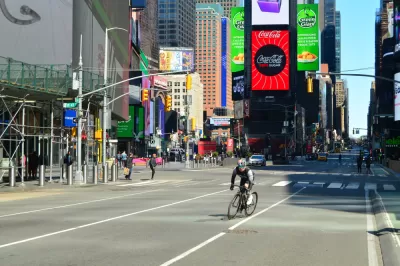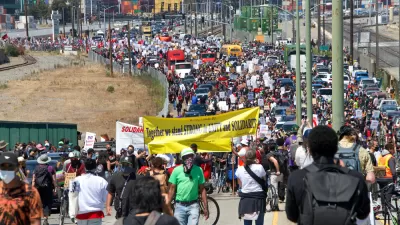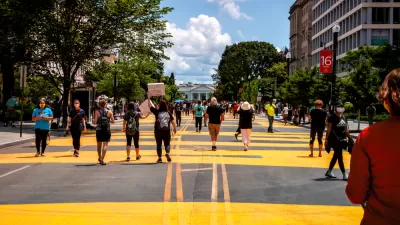After three months of study and analysis, NACTO is providing authoritative guidance on new ways of thinking about rights of way now that the coronavirus has changed the way we live and work in cities.

The National Association of City Transportation Officials (NACTO) released a new guide to street design for the ongoing pandemic and the future recovery.
The "Streets for Pandemic Response and Recovery" report showcases specific design and management tools "to keep essential workers and goods moving, provide safe access to grocery stores and other essential businesses, and ensure that people have safe space for social/physical distancing while getting outside," according to NACTO.
The report includes descriptions of emerging practices from around the world as well as implementation resources for communities. The following street features are addressed specifically in the report:
- Lanes for Biking & Rolling
- Sidewalk Extensions
- Transit Lanes
- Slow Streets
- Pick-Up & Delivery Zones
- Outdoor Dining
- Markets
An article by Kea Wilson provides additional background on how NACTO created the report, and shares insights into a few of the larger themes present in the report, liking designing for equity, the need for flexibility in design response, the post-pandemic sidewalk, and the need to balance outdoor restaurant space with space for pedestrians. Wilson wrote a separate article to address that last point more specifically, and in greater detail.
FULL STORY: Streets for Pandemic Response and Recovery

Manufactured Crisis: Losing the Nation’s Largest Source of Unsubsidized Affordable Housing
Manufactured housing communities have long been an affordable housing option for millions of people living in the U.S., but that affordability is disappearing rapidly. How did we get here?

Americans May Be Stuck — But Why?
Americans are moving a lot less than they once did, and that is a problem. While Yoni Applebaum, in his highly-publicized article Stuck, gets the reasons badly wrong, it's still important to ask: why are we moving so much less than before?

Using Old Oil and Gas Wells for Green Energy Storage
Penn State researchers have found that repurposing abandoned oil and gas wells for geothermal-assisted compressed-air energy storage can boost efficiency, reduce environmental risks, and support clean energy and job transitions.

Colorado Lawmakers Move to Protect BRT Funding
In the face of potential federal funding cuts, CDOT leaders reasserted their commitment to planned bus rapid transit projects.

Safe Streets Funding in Jeopardy
The Trump administration is specifically targeting bike infrastructure and other road safety projects in its funding cuts.

Six Reasons Why Housing Is a Human Right
Is housing a human right? A law professor shares six reasons why it should be, from its role in protecting other rights to global recognition and U.S. legal traditions. As public support grows, could housing be the next right written into law?
Urban Design for Planners 1: Software Tools
This six-course series explores essential urban design concepts using open source software and equips planners with the tools they need to participate fully in the urban design process.
Planning for Universal Design
Learn the tools for implementing Universal Design in planning regulations.
Heyer Gruel & Associates PA
City of Moreno Valley
Institute for Housing and Urban Development Studies (IHS)
City of Grandview
Harvard GSD Executive Education
Salt Lake City
NYU Wagner Graduate School of Public Service
City of Cambridge, Maryland





























